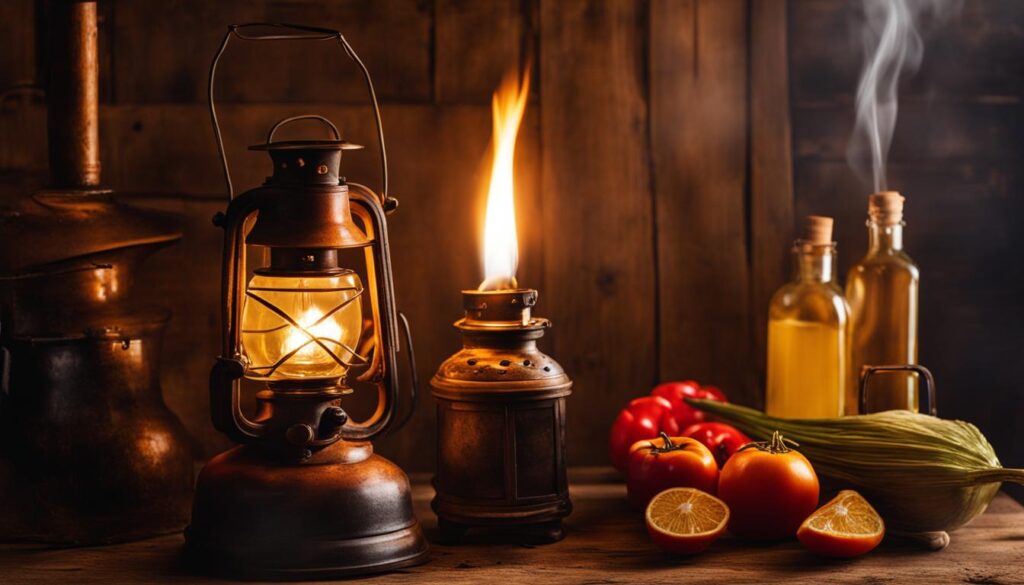Looking for a cost-effective and eco-friendly way to light up your space? Making your own lamp oil at home is the answer! With just a few supplies and easy steps, you can create homemade lamp oil that is safe, environmentally friendly, and perfect for power outages or creating ambiance.
In this guide, I will walk you through different methods of making lamp oil at home. You’ll learn how to create your own lamp oil using everyday items and customize it to suit your preferences. Whether you’re in need of emergency lighting or simply want to add a unique touch to your space, homemade lamp oil is the way to go.
So, let’s dive in and discover how to make lamp oil, the recipe for homemade lamp oil, and all the steps you need to follow to create your very own homemade lamp oil.
Method 1 – Mason Jar Lamp
In this section, I will guide you through the process of making lamp oil using a mason jar. This method is simple and requires just a few supplies. Here’s what you’ll need:
- A squat mason jar or bowl
- 100% cotton cord or lamp wick
- Craft knife
- Scissors
- Cork
- Nail and hammer
- Olive oil
- Water (optional)
To start, cut the cork to be flat on the bottom and poke a hole in the center for the wick. Trim the wick to fit inside the jar and fill the jar with olive oil. If desired, you can add a small amount of water to the oil to create a more efficient burn. Place the cork on top of the oil, allowing the wick to absorb the oil. Finally, light the lamp and enjoy the warm glow!
Using a mason jar for your homemade lamp oil is a cost-effective and creative way to light up your space. Whether you’re using it during a power outage or for a cozy ambiance, this method is sure to impress. Now, let’s move on to the next method.
Method 2 – Wire and Jar Lamp
Another method to make lamp oil at home involves using a jar and wire. This method is simple and requires just a few supplies. You will need a squat mason jar, 100% cotton cord or lamp wick, olive oil, scissors, floral wire, and wire cutters.
To start, trim the wick to fit inside the jar. Next, fold the wire in half, sandwiching the wick between the two halves. Position the wick over the center of the jar and hook the end of the wire over the lip of the jar. Make sure the wire is secure and the wick is in the desired position.
Once the wire and wick are set up, fill the jar with olive oil. It is important to wait for the wick to soak up the oil before lighting it. This can take a few minutes, so be patient. Once the wick is saturated, you can light the lamp and enjoy the warm glow of your homemade lamp oil.
Method 3 – Mason Jar Lid Lamp
If you’re looking for another method to make lamp oil at home, using a mason jar lid could be a perfect option. This method is simple and effective, requiring just a few supplies. Here’s a step-by-step guide on how to make lamp oil using a mason jar lid:
Gather Your Supplies
To begin, gather the following supplies: a mason jar, a mason jar lid, 100% cotton cord or lamp wick, olive oil, a hammer, a screwdriver or nail, pliers (optional), two blocks of wood, tape (optional), and a metal washer or nut.
Punch a Hole in the Mason Jar Lid
Place the mason jar lid upside down between two blocks of wood to hold it in place. Use a hammer and a screwdriver or nail to punch a hole in the center of the lid. This hole will be used to thread the wick through.
Thread the Wick and Add the Oil
Take the 100% cotton cord or lamp wick and thread it through the hole in the mason jar lid. Consider adding a metal washer or nut over the wick to help keep it in place. Place the lid back on the jar and fill the jar with olive oil. The wick will absorb the oil, allowing it to burn and produce light.
Enjoy your homemade lamp oil and the warm glow it brings to your space!
Customize Your Lamp
Now that you have made your lamp oil using one of the methods outlined in the previous sections, it’s time to add a personal touch to your creation. Customizing your lamp oil can elevate the overall experience and make it truly unique to you.
One way to customize your lamp oil is by adding a few drops of your favorite essential oil or candle fragrance. This will not only provide a pleasant scent but also create a soothing ambiance when the lamp is lit. Experiment with different scents to find the perfect combination.
In addition to fragrance, you can also enhance the appearance and scent of your lamp by adding decorative elements. Consider placing sprigs of woody herbs, like rosemary or lavender, into the lamp oil. This will not only add visual interest but also infuse a delightful aroma into your space. Alternatively, you can add slices of citrus fruits for a refreshing and invigorating scent.
Experiment with Colors
If you are using water in your lamp oil mixture, you can get creative with colors. Add a few drops of food coloring to the water before mixing it with the oil. This will create a beautiful striped effect that adds a touch of vibrancy to your lamp. Choose colors that complement your space and create the desired ambiance.
Remember, the possibilities are endless when it comes to customizing your lamp oil. Feel free to explore and experiment with different fragrances, decorative elements, and colors. Let your creativity shine and create a lamp oil that brings joy and warmth to your home.
Pros and Cons of Vegetable Oil vs. Store-Bought Lamp Oil
When it comes to making your own lamp oil at home, you have the option to choose between vegetable oil or store-bought lamp oil. Each option has its pros and cons, so let’s explore them further to help you make an informed decision.
Vegetable Oil
Using vegetable oil, such as olive oil, as your lamp oil has several advantages. Firstly, it is a natural and eco-friendly choice. Vegetable oil is derived from plants, making it renewable and sustainable. It is also safe to use and does not produce harmful byproducts when burned. Additionally, vegetable oil is readily available in most households, making it a convenient option for those who prefer a DIY approach.
However, there are some downsides to using vegetable oil as lamp oil. It tends to burn slower and with more smoke compared to store-bought lamp oil. This can result in a less efficient burn and may require more frequent wick trimming. Additionally, vegetable oil may have a lower flash point, which means it can be more challenging to ignite the wick. Despite these limitations, vegetable oil remains a popular choice for those looking for a natural and cost-effective alternative to store-bought lamp oil.
Store-Bought Lamp Oil
Store-bought lamp oil, typically made from petroleum, offers its own set of advantages. One of the main benefits is its higher flash point, which makes it easier to ignite the wick and maintain a consistent flame. The higher flash point also contributes to a cleaner burn, resulting in fewer emissions and less smoke. Additionally, store-bought lamp oil tends to have a longer shelf life, making it a more durable option for long-term use.
However, store-bought lamp oil also has some drawbacks. It is more expensive compared to vegetable oil, which may not fit everyone’s budget. Furthermore, store-bought lamp oil is not as environmentally friendly as vegetable oil, as it is derived from non-renewable fossil fuels. If sustainability is important to you, vegetable oil may be a preferable choice.


Conclusion
Making your own lamp oil at home using the methods outlined in this guide is a simple and rewarding process. Whether you choose to use vegetable oil or store-bought lamp oil, you can create a cost-effective and eco-friendly solution to light up your space. By following a few easy steps and utilizing readily available supplies, you can have homemade lamp oil at your disposal.
Experimenting with customization options allows you to personalize your lamp oil. Add a few drops of your favorite essential oil or candle fragrance to create a pleasant aroma. Enhance the appearance and scent of your lamp by including decorative elements like woody herbs or citrus slices. For those using water in their lamps, consider adding food coloring to create a unique striped effect.
With homemade lamp oil, you have the flexibility to choose between vegetable oil or store-bought lamp oil. Vegetable oil, like olive oil, offers a natural and eco-friendly alternative. Although it may burn slower and produce more smoke, it is safe to use and doesn’t release harmful byproducts. On the other hand, store-bought lamp oil, derived from petroleum, burns cleaner and has a lower flash point. While it may be more expensive, it provides a more efficient burn and longer-lasting wicks.
So, why not give it a try? Follow the steps in this guide and create your own homemade lamp oil. Illuminate your space while enjoying the satisfaction of a DIY project. With the right supplies and a little creativity, you can transform your space into a warm and inviting oasis, all with the flicker of homemade lamp oil.
FAQ
Can I use any type of oil to make lamp oil at home?
Yes, you can use vegetable oil such as olive oil or store-bought lamp oil.
What is the advantage of using vegetable oil?
Vegetable oil is natural, eco-friendly, and safe to use. It does not produce harmful byproducts.
Is there a difference in burn time between vegetable oil and store-bought lamp oil?
Yes, vegetable oil may burn slower and with more smoke compared to store-bought lamp oil.
Which type of lamp oil provides a more efficient burn?
Store-bought lamp oil, made from petroleum, has a lower flash point and burns cleaner, providing a more efficient burn and longer-lasting wicks.
Can I customize my homemade lamp oil?
Yes, you can add a few drops of your favorite essential oil or candle fragrance into the oil lamp for a more fragrant smell. You can also add decorative elements such as woody herbs or citrus slices.








